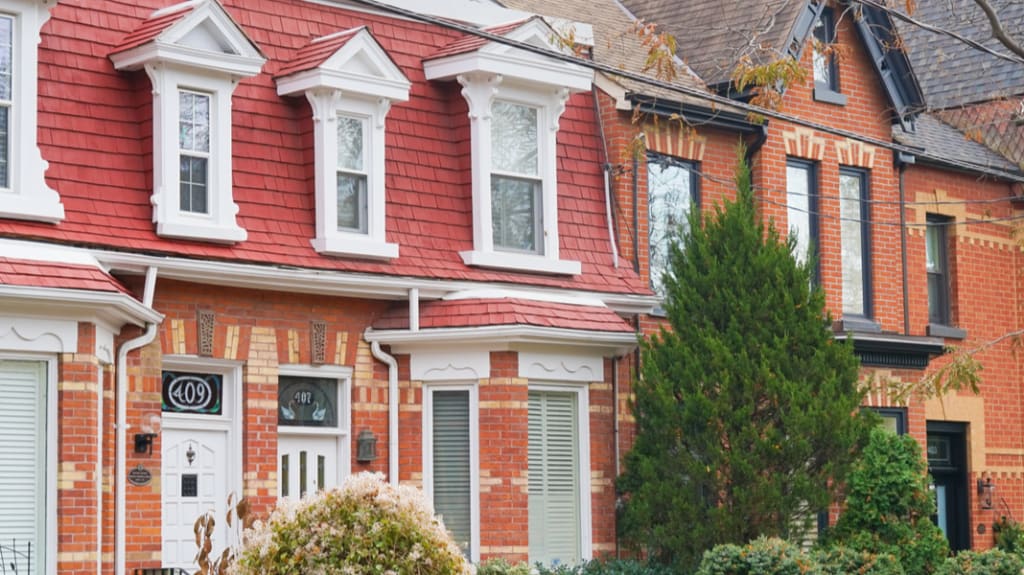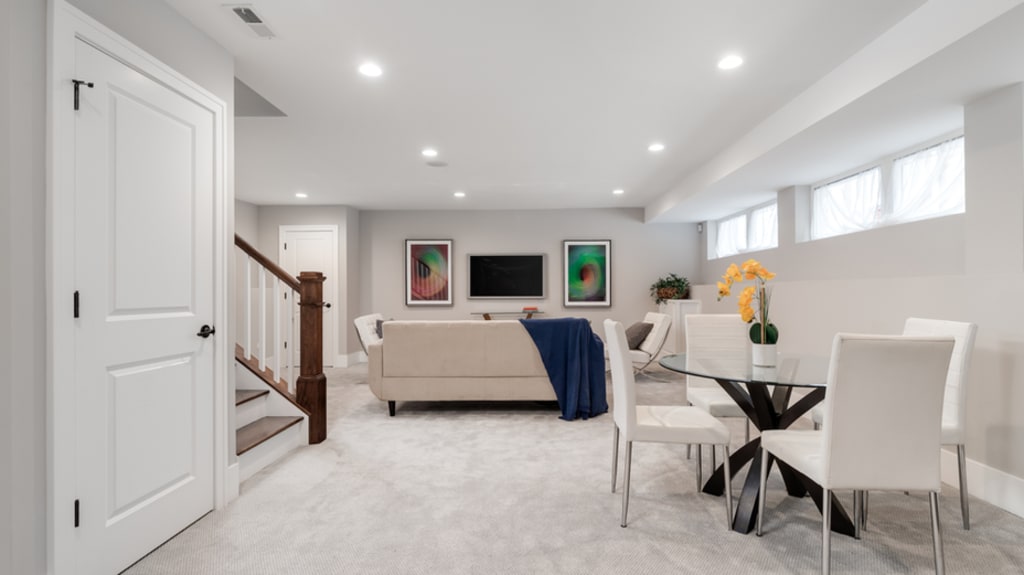There’s more to renovating a basement than nailing down an aesthetic and putting up drywall. Add in the musty smells, foundation cracks, exposed ductwork, and wiring, and you’ve got a big project with a lot of moving parts! From the initial planning stages to the final details, knowing how to renovate a basement can save you a lot of time and heartache. Looking to get off on the right foot? Our experts have compiled a list of 20 tips to help you prepare for your basement remodel.
1. Have a goal in mind
Before you start remodeling a basement, take some time to get a general idea of what you want the space to look like. Ensure that it’s a design that has some longevity. Browse social media or interior decorating magazines, or anywhere else that you search for inspiration, and then compile a collection of photos and ideas you like or create a mood board. If you’re looking for a good place to start, check out the latest styles and trends.
Options for renovating a basement
A basement can have a variety of functions – it doesn’t have to be a simple storage area! Here are a few basement renovation ideas to get you started.
Home gym
Movie theatre
Wine cellar
Game room
Kids’ playroom
Art studio

2. Pick a layout
Now that you’ve nailed down the purpose of the new space, the layout of the area should be your next key point. Of course, this depends entirely on what you want the space to be.
Are you planning on adding a second unit to your house? If so, then a neutral design with a practical open layout would give tenants the opportunity to customize the space as they wish. Keep in mind that your renovation will require a few specific rooms: a living room, a kitchen, a bathroom, and a bedroom. Equally, make sure that your second unit meets the Building Code.
If you’re planning a multipurpose space, then an open concept layout is the way to go! Just add room dividers as needed in the future. Looking to make an area for the kids? Consider a layout featuring a bedroom (or two), a sizable play area, and a bathroom. And of course, if you’re thinking of creating the ultimate home theatre, be sure to have a large open space with a bathroom and a small kitchen for snacks.
Walls and framing
A big part of designing the floor plan includes determining where walls will be built. Remember to prioritize functionality when renovating a basement. For example, avoid placing a guest bedroom right next to a laundry room without adequate soundproofing. Equally, spatial needs should be kept in mind. A bathroom should not be larger than a bedroom, and make sure there’s enough clearance for the doors and hallways between rooms.

3. Set a budget
When it comes to renovating, the most important thing is always the budget. Make sure to research this carefully and set the budget at a sensible level. It’ll determine the materials and finishes that you can afford, as well as the final quality of the basement itself.
How much does it cost to renovate a basement?
The cost of a basement renovation will ultimately depend on the different finishes and elements you want. Before you get too far into your project, compile a list of your must-haves, nice-to-haves, and extras in a spreadsheet, along with associated price points. It will help you get a big-picture view of total costs. This way, if you’re working with a small budget, you can pick one spot to splurge. It’ll give you something to look forward to!
Keep in mind that adding a kitchen or bathroom will be effectively the same as adding an entire kitchen or bathroom renovation on top of the original price.

Is renovating a basement myself an option?
This isn’t recommended unless you are a licensed contractor who knows how to renovate a basement. It is a huge project to undertake, on top of a job and other day-to-day activities. Furthermore, if you attempt to do any plumbing or electrical work without a licence, you will void your house warranty and insurance.
Will local codes affect the final price?
This will depend on what your choice for the basement is. For example, if you have chosen to renovate a basement into a second unit, then Building Code laws will require you to build a second exit or an egress as a means of escape. Likewise, an egress would be required if you were to renovate your basement into a bedroom.

4. Clean out your space
The first step to renovating a basement is clearing out the space. If you’re like many others and use it as a storage area, then now it’s time to start sifting through it all and sort out what you don’t need. There are many opportunities for it to be reused – items can easily be donated, given to a charity, or sold off at a good old-fashioned garage sale.
If you have more stuff worth keeping than you can store in your house, it may be worth renting out a temporary self-storage area to host them.

5. Get an inspection done
Unless you’re using your basement regularly, it’s possible that many problems may have escaped unnoticed. They can range from moisture and mildew to iron ochre and even foundation cracks. Before you begin renovating a basement, hire a professional to inspect the space for any potential issues. You can then get them dealt with before you start renovating or ask the contractor to carry out the repairs when they begin the renovations.

Renovating a basement with high humidity
A basement should preferably have humidity levels under 50%. If the humidity exceeds 80% on a regular basis, you run the risk of a mould and mildew outbreak, which thrive in humid conditions. None of this is good, as it can cause damage to the rest of your house and be a danger to your health. But don’t worry! You can install a dehumidifier and ensure good circulation, as well as take steps to eliminate moisture sources.
Also, it is probably not the best idea to install wall-to-wall carpeting in a newly renovated basement. Carpets help retain moisture, which means even with the steps taken to eliminate mould, it could still pop up anyway. If you really want a soft surface, opt for rugs or carpet tiles!

Get pests under control
Insects are great for the wildlife but having them uncontrolled in your house can pose problems. Carpenter ants, for example, can damage the wooden foundation of your house. Take steps to remove them if they’re present and ensure that you ask your contractor to seal any entry points, so they never make their way in and cause problems in the future.

6. Familiarize yourself with local laws
Before you start renovating a basement, always double check to make sure that what you’re doing complies with local laws. Regulations for a second unit can be strict in some areas. The government of Ontario has already published a user-friendly guide that outlines rules for building a second unit, but some municipalities may not allow you to build one at all. It’s best to do this research before you invest in something that ultimately turns out to be an illegal venture.

7. Be smart about storage
You may have cleared out your basement for the project, but you’ll have to bring those items back at some point. Unless you want it to return to that cluttered mess once more, you’ll need to consider storage solutions. Built-in shelving, a closet under the stairs, or even a dedicated storage room are all options that you can choose when renovating a basement, so keep that in mind when designing the layout.

8. Consider soundproofing
A children’s playroom, a bar for adults, a home theatre… A lot of the potential uses for a basement can be noisy. If you want to stop noise from travelling through the rest of your house, then you may want to invest in basement soundproofing. In the case of a second unit, soundproofing would give some extra privacy to both you and your tenant.

9. Upgrade your windows
Any windows that descend below ground level will require window wells, of course. But keep in mind that you can go beyond the simple corrugated metal design; fibreglass and faux stone are both valid options to create a unique and interesting look to the wells.
You can also expand the window sizes. That said, this can be a bit expensive as the contractor will need to cut through any concrete, brickwork, and siding panels that happen to be in the way.

10. Make room for food
Have you considered renovating a basement to include a kitchen area, but found it was out of your price range? Not to worry – you can achieve something similar with a smaller snack area. Add in a mini fridge, a few cupboards to hold some snacks and drinks, and a station to brew some coffee or tea, and you’re ready to go!
Such a simple area can have a huge effect. It saves you a trip upstairs every time you want a drink and makes the whole area a lot cozier and inviting.

11. Add a bathroom
Similar to the point above, running up and down the stairs just to relieve yourself is not fun. It only gets worse when you have to do it in the middle of the night. If you’re considering turning the basement into a new guest bedroom or a general communal space, it may be worth just adding a bathroom for the convenience. And, of course, if you are installing a second unit, then a bathroom will be required by law.
If you happen to have the extra room, then installing a washing machine or dryer down here could also go a long way. It’ll help free up some extra space in the rest of your house if you already have a laundry room.

12. Make it multipurpose
A lot of people struggle to grasp how they can renovate a basement to include so many things when limited by space. The key is to get creative and find possible new ways to organize everything! Take this photo, for example.
You can see how the homeowners removed a bulky closet and replaced it with a simple and space-efficient coat hanging area with wall hooks, giving room for an open shoe shelf underneath. The washer and dryer have been moved from being beside each other into a stacked position, which has created room for a sink area and storage for food and drinks. A few simple changes can go a long way to create more space.

13. Build better stairs
If you’re renovating a basement, then it is likely you’ll be renovating the stairs as well. As with everything else, you’ll need to make sure that these new stairs, or the old ones if you’re keeping them, meet the Building Code for your area. But there are other things to keep in mind, too. If the stairs are in a bad location, consider moving them to a new area of the house. If someone in your family has limited mobility, consider widening the stairs to accommodate their needs – you almost certainly will need to if you intend to include a chairlift.

14. Keep the heat in with insulation
Both the cold and damp are common issues with a basement. The good news is that you can avoid these complaints with some quality insulation. This is a key point if you know how to renovate a basement, especially as it can keep energy costs down in the future. So, take the time to run over the different options for insulation and ensure what you have will keep you, and anyone else who uses the basement, comfortable.

15. Choose flooring carefully
The flooring is one of the most important elements of renovating a basement, as some simple design choices can have huge impacts. Wall-to-wall carpeting may seem like a good choice, but it will retain moisture and invite mildew. So, unless you’re prepared for the odour and the feeling of damp fabric beneath your feet, it’s not recommended.
Of course, other floors have their drawbacks, too. Hardwood can warp, and tiles will feel cold to the touch. Take some time to consider the pros and cons of different flooring materials before selecting.

Warmth underfoot
If you just place the flooring straight on to the concrete foundation, not only will it feel extremely cold, but you also invite a risk of moisture related issues. Instead, add subflooring to separate them. If you have the budget to do so, and feel like going the extra mile, you could install a heated floor to ensure the ground stays warm underfoot all year round.
16. Decorate the walls
Renovating a basement but forgetting the walls would be a mistake, and there are so many ways that you can detail them. Think trendy paint colours, elaborate artwork, lighting… Even sconces can serve as amazing wall décor if done right. Wood panels are great for a natural touch, as are wicker and rattan accents. You can, of course, mix and match these ideas and others to create your dream space.
One thing worth keeping in mind: colour choice is key. Warmer colours will help to brighten rooms, as will natural materials. This is great for bedrooms, bathrooms, and offices. In contrast, darker colours, of course, will help to darken a space, which is useful for the likes of a home theatre and gaming room.

17. Don’t forget the ceiling
With so much focus on the walls, floors, and furniture, it’s easy to forget to give the ceiling a treatment. A plain white ceiling may be the norm but leaning into architectural ideas can bring a unique look to the entire area.
Lining up wooden beams between vents and pipes as a faux structural support can create a more rustic feel, and painted beams can create some depth. If you want to be able to access the plumbing, vents, and electrical equipment, then consider a floating ceiling. Even the simplest designs, such as painting the ceiling or a mural, can help bring out the atmosphere of the room.

18. Invest in good lighting
Another element of the ceiling (or walls) worth considering is lighting. For most basements, pot lights are the norm, as they suit the typically low ceilings found there. Keep in mind that these are generally on the higher end of cost (they can be $85 to $250 per installed light), which might turn away someone with a smaller budget. Wall-based lighting, such as sconces, is an alternative worth considering. Whichever way you decide to renovate a basement, make sure it is bright enough to keep the place inviting.

19. Focus on the details
The floors, walls, and ceilings may be sorted, but you’re going to be living in the space between them all, and that is where the most important details lie. The simple addition of a fireplace, soft rugs, and leather sofas can create a warm and inviting appearance for an open space. Built-in storage will ensure the area remains clean and tidy, and lighting in the storage area can make all the difference. Room dividers can also help add character while creating division. The personality of a room can be altered by simple changes, so dress it up or down as you like.

20. Hire a contractor
And the last point here may arguably be one of the most important. If you decide to undertake this project yourself, you’ll be dealing with building permits, Building Code requirements, hiring subcontractors, and so much more on top of your work and anything else in your life.
You’ll save both time and money if you hire a licensed contractor who knows how to renovate a basement to handle all of this work for you. And, as a bonus, you’ll find yourself less stressed and will probably enjoy the final product even more.

Future-proofing your basement renovation
Now you’ve got a general idea of how to renovate a basement, it’s time to unlock your basement’s full potential. If you’re still unsure where exactly to begin, it’s worth going back to the first few steps and getting an idea of the budget and initial things you’ll need to consider. Be sure to check out the latest home trends as well for designs you’ll love for years to come.





